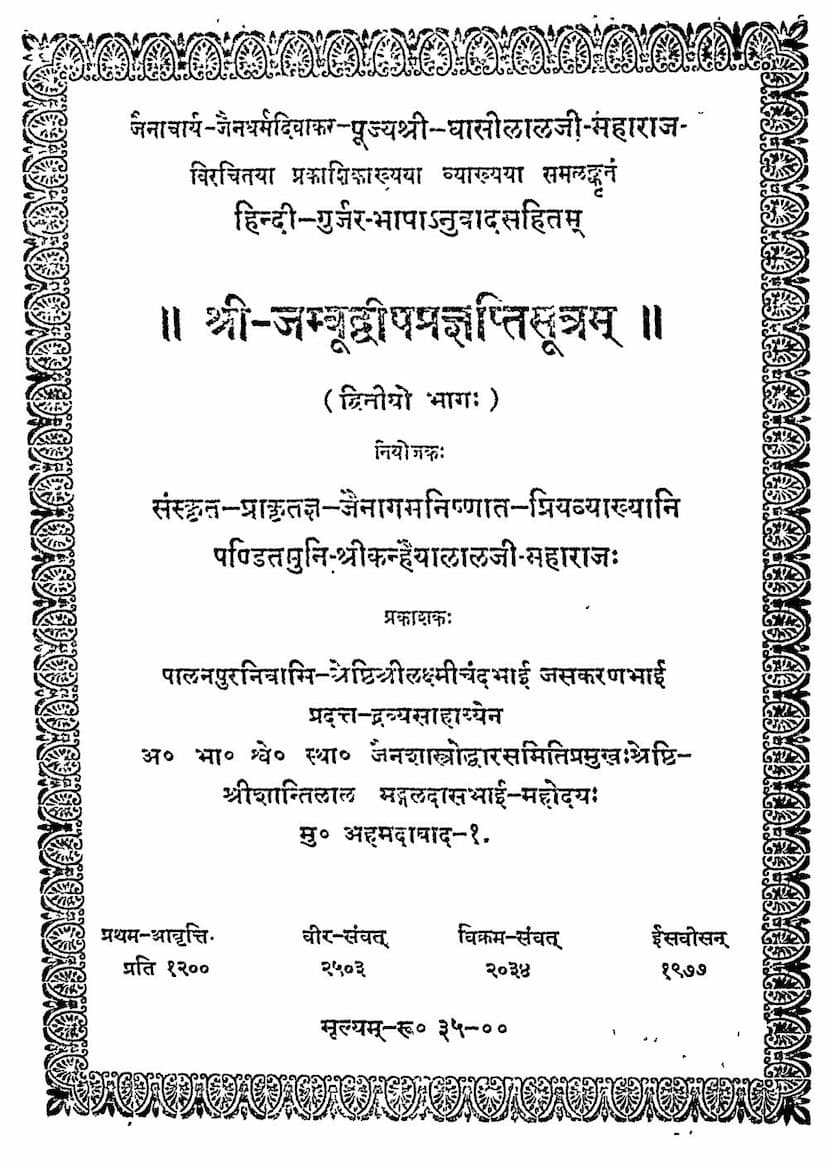Jambudwip Pragnaptisutram Part 02
Added to library: September 2, 2025

Summary
This Jain text, "Jambudvip Pragnyapti Sutram Part 02" by Ghasilal Maharaj, is a detailed exploration of the geography and cosmology within the Jain universe, specifically focusing on the continent of Jambudvipa. As indicated by the catalog link and publisher, it's a scholarly work dedicated to preserving and explaining ancient Jain scriptures. This part of the text, as detailed across the provided pages, delves into the intricate descriptions of various mountains, rivers, regions, and celestial beings inhabiting the Jambudvipa continent.
Here's a breakdown of the key themes and content based on the provided pages:
Core Subject Matter: Jambudvipa and its Geography
The text meticulously describes the layout and features of Jambudvipa, the central continent in the Jain cosmological model. It focuses on:
-
Yeardhar Mountains (वक्षस्कार पर्वत / वर्षधर पर्वत): These are monumental mountain ranges that divide and define the different regions within Jambudvipa. The text details several of these, including:
- Himavan (हिमवान): Specifically, the "Chulla Himavan" (क्षुद्र हिमवान् / चुल्ल हिमवत्), described with its dimensions, location, and characteristics.
- Mahahimavan (महा हिमवान): This appears to be a larger counterpart or a related mountain.
- Gandhamadana (गंधमादन): A prominent mountain range described in detail, including its location, dimensions, associated deities, and cities.
- Nishadha (निषध): Another significant mountain range described with its characteristics and associated regions.
- Chitrakuta (चित्रकूट): Mentioned in relation to the regions it divides.
- Vendhyas (वैताढ्य): A significant mountain that acts as a dividing line.
- Malya (माल्यवान): Another described mountain range.
- Nilavan (नीलवान): A key mountain defining the boundaries of regions.
-
Rivers (नदी): The text names and describes major rivers flowing through Jambudvipa, such as:
- Ganga (गंगा): Its course, source, and dimensions are detailed, often in relation to its majestic descent.
- Sindhu (सिंधु): Likely another significant river with its own geographical description.
- Rohita (रोहिता/रोहितांसा): A river described with its path and characteristics.
- Harikanta (हरिकान्ता): Another river mentioned.
- Shita (शीता): A river that forms boundaries.
-
Regions/Lands (क्षेत्र / वर्ष / विजय): The mountains and rivers divide Jambudvipa into distinct regions or "lands" (Varshas) and "victories" (Vijayas), which are described in detail. These include:
- Bharatavarsha (भरत): One of the primary regions.
- Haivatavarsha (हैमवत): Described with its dimensions and relation to Himavan and Bharat.
- Devakuru (देवकुरु): A significant region, likely a heavenly abode or a land of celestial beings.
- Uttarkuru (उत्तरकुरु): Another important region, often described in contrast or comparison to Devakuru.
- Harivarsha (हरिवर्ष): A region detailed with its geography and associated deities.
- Mahavideha (महाविदेह): This appears to be a vast and central region, often described as being further divided into other areas like Purva-Videha, Apara-Videha, Devakuru, and Uttarkuru.
- Kachchha (कच्छ): A specific region within Mahavideha, described with its boundaries, dimensions, and administrative divisions.
- Sukachchha (सुकच्छ): Likely a neighboring or related region to Kachchha.
- Magalakachchha (मंगलावती?): Mentioned in relation to administrative divisions.
- Plakshadvipa and Shalmali Trees (प्लक्षद्वीप, शाल्मलीवृक्ष): These are mentioned as significant geographical features or concepts, possibly referring to other continents or symbolic representations.
-
Cities and Royal Residences (राजधानी): The text frequently mentions capitals and royal residences, often associated with specific deities or rulers who govern these regions. Examples include those related to Yataka-devas and the capitals of various regions like Kshemapura, Sukshma, etc.
-
Deities and Celestial Beings (देवता / देव): The text describes the presence and roles of various celestial beings, often associated with specific mountains, rivers, or regions. These include Yakshas, Vanavasis (forest dwellers), and other divine beings who inhabit these geographical features.
-
Mathematical and Dimensional Descriptions: A significant aspect of the text is its precise, albeit complex, mathematical and dimensional descriptions of these geographical entities. Heights, widths, lengths, and circumferences are given in yojanas (a unit of distance), providing a structured, almost scientific, approach to their cosmology.
-
Commentary (व्याख्या / प्रकाशिका): The text is attributed to Acharya Ghasilal Maharaj and features a commentary (प्रकाशिकाख्यया व्याख्यया). This commentary, likely by Pandit Kanhaiyalalji Maharaj, provides explanations and interpretations of the original sutras.
Key Concepts Highlighted:
- Cosmological Framework: The entire description is rooted in the Jain understanding of the universe, which is structured into various continents (Dweepa) and levels of existence.
- Division of Jambudvipa: The yeardhar mountains play a crucial role in dividing Jambudvipa into distinct regions, each with its own characteristics and governing deities.
- Symbolism: While providing geographical details, Jain scriptures often imbue these descriptions with symbolic meaning, representing spiritual principles or stages. The descriptions of jewels, lotuses, and specific mountain shapes might carry such symbolism.
- Devotion and Sponsorship: The publisher's note and the initial pages often mention patrons and donors, highlighting the devotional aspect and community support for such scholarly religious works.
Overall Purpose and Tone:
The text aims to provide a comprehensive and accurate description of Jambudvipa according to Jain tradition. The tone is scholarly and reverential, seeking to explain complex cosmological and geographical details based on ancient Jain canonical texts. The use of Sanskrit and Prakrit terms, along with their Hindi and Gujarati translations, indicates an effort to make the knowledge accessible to a wider audience while respecting the original language of the scriptures.
In essence, "Jambudvip Pragnapti Sutram Part 02" is a foundational text for understanding the spatial and temporal framework of the Jain universe, offering a detailed, systematic, and deeply symbolic view of the central continent, Jambudvipa.